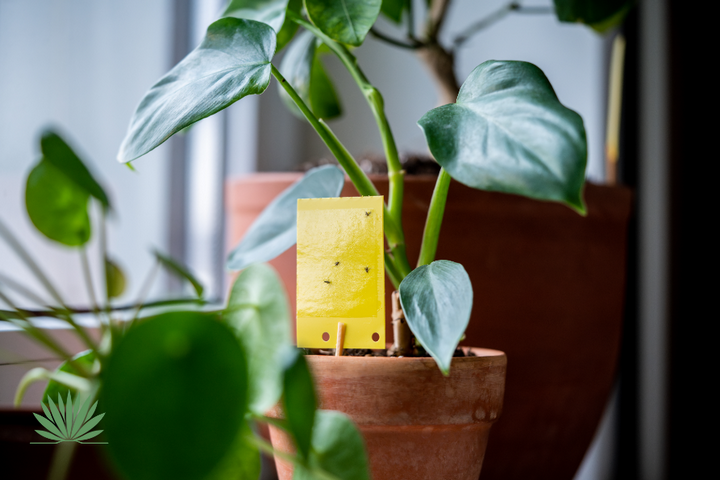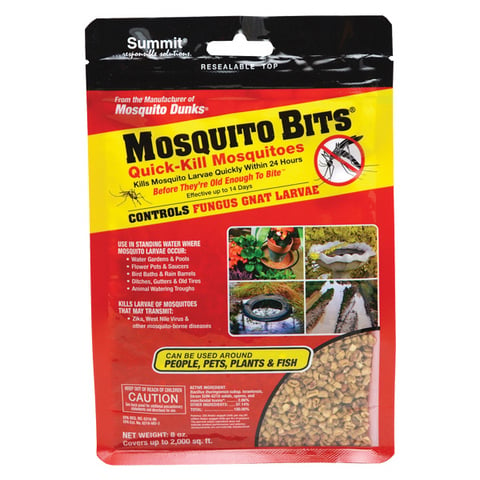If you have gnats hovering around your houseplants, they are probably fungus gnats. There are loads of DIY fungus gnat remedies promoted online, but most fail for one simple reason. Learn why a two-pronged approach is necessary to conquer these annoying pests once and for all.

If you have houseplants, you might be all too familiar with this scenario. You see small black dots hovering over your houseplants and occasionally elsewhere in your home. Sometimes they even buzz your face.
These are fungus gnats (Bradysia spp.). They get into your home and plants by hitching a ride with new houseplants. Sometimes they are living in bags of potting soil. And once in your home, they fly from plant to plant, especially if you have a lot of plants in one room or area.
These annoying pests spend most of their lives in houseplant soil, where they rapidly multiply. And once you’ve got an infestation, they can be frustratingly difficult to get rid of.
They are usually more annoying than harmful, but too many can damage your plants causing wilting, stunted growth, iron chlorosis and leaf loss.
There are many remedies that seem to work… for a while. But before you know it, they’re back.
Let’s jump right in with what works. Then we’ll look at preventive measures you can take. And finally, you can learn more about the remedies that you should skip because they don’t work and why.
Two-Pronged Approach That Works
The lifecycle of fungus gnats has four stages — egg, larva, pupa, and adult. The first three occur in the soil unseen. The final, adult stage is the one we’re all familiar with.
To get rid your plants of fungus gnats, you need to simultaneously get rid of the adults and the egg/larvae/pupa stages. And to do this you need a two-pronged approach.
Amazing Fact!
Each female adult gnat lives only
a few weeks but can lay 300 eggs.
Sticky Traps for Adults
Getting rid of the adults is pretty straight forward. Attract and capture them with yellow sticky traps. These work quite well. They are easy to find and inexpensive, especially if you buy large squares that you cut to size. The cutesy ones shaped like flowers or butterflies are much more expensive and not all that cute once they’re covered in gnats.
There’s no need to mess with bowls of vinegar and soap, an oft-recommended DIY remedy. The smell of vinegar gets sickening fast, and I didn’t find that it worked any better than putting out a dish of water.
Caution!
Don’t use sticky traps outside.
They attract and catch beneficial insects
along with the gnats.
Another DIY attractant is raw potato slices. You can use this if you have a gnat problem in your outdoor potted plants.
Treatments for Soil-Dwelling Stages
Now let’s take a look at proven ways to get rid of the soil-dwelling stages of fungus gnats, plus one anecdotal way that looks promising.
Bti
You may have heard of Bt (Bacillus thuringiensis), a naturally occurring bacteria that is used to kill caterpillars. Bt products have been safely used for decades and are harmless to people, pets, and plants.
But Bt is not effective against fungus gnats.
However, Bti (Bacillus thuringiensis sp israelensis) is a subspecies of Bt that kills the larval stages of mosquitoes, fungus gnats, and blackflies, while having almost no effect on other organisms.
Let’s take a look at 2 commercial products that contains Bti.
Mosquito Bits is the most popular Bti treatment for fungus gnat larvae. The bits are made of corn cobs that contain 2.8% Bti and will break down over time. It’s easy to find at hardware stores, garden centers, Arbico Organics, and on Amazon.
Here are the manufacturer’s directions when using it to control fungus gnats.
“Mix 4 tablespoons of Moquito Bits® per 1 gallon of water. Soak for 30 minutes and skim off the floating granules. (Granules may be placed in a nylon stocking prior to immersion in water.) Stir or shake the water then apply treated water directly to soil or growing media surface. Compost or discard used granules.”
The process is a little complicated, but if granules are left to sit on top of the soil, they get moldy.

Unlike Mosquito Bits, Biognat is not very well-known. But it has two advantages over “the bits”.
- It contains 37.4% Bti, making it 13 times more potent than bits.
- This product’s instructions are simple. Add to water and drench your plants. (No soaking or skimming required.)
It can only be ordered from the Biognat.com website, but is worth seeking out. They have free shipping (no minimum), and even throw in a free sticky trap. 😉
Bonide Systemic Granules
Before I learned about Bti, I tried Bonide systemic granules. It worked like a charm, but contains a chemical insecticide, imidacloprid.
Knowing what I know now, I would try Biognat first. However, since I already have this, I wouldn’t hesitate to use it if I have another gnat outbreak. (I don’t have kids or pets that would get into it, I’m not using it on edible plants, and it breaks down quickly when exposed to water and sunlight.)

Cinnamon (maybe?)
I’ve learned from gardeners in the UK and Canada, that Mosquito Bits and Bonide systemic are not readily available everywhere. (I’m as surprised as you are that I have readers in the UK! 🤗)
If that’s the case for you, or you’d just like to try something you have in your kitchen cabinet, try cinnamon. This is one home remedy that shows some real potential for treating fungus gnats.
Cinnamon has known antibacterial and anti-fungal properties. It works as an insect repellent, and in high doses, can prevent insects from laying eggs. It’s speculated that it might also work by killing fungus in the soil, which is the larval food source.
You can sprinkle powdered cinnamon on top of the soil. You can also try mixing it with water, but I find it floats rather than dissolves.
Fungus Gnat Prevention Tips
Once you’ve got your gnat problem under control, you don’t want it to come back. Here are some ways to prevent fungus gnat infestations.
🪴Don’t overwater your plants. The adults lay their eggs on moist soil. Overwatering also increases fungus, the larval food source, in the soil.
🪴Always keep a few sticky traps up as an “early warning detection system” for the flying adults. That way, you’ll know as soon as you have an infestation brewing.
🪴Quarantine any new houseplants. When you bring a new plant home, pop a sticky trap in its soil. Then wait until you’re confident your new plant does not harbor any fungus gnats before introducing it to the rest of your houseplant gang.
🪴Carefully monitor your plants when using new potting soil. Try to buy bags of potting soil that are on the dry side, not sodden with moisture. (I have no doubt that my gnats came from infested potting soil.)
🪴Compost is the perfect food for fungus gnats, so don’t add it to your potting mix.
DIY Home Remedies to Skip
There are tons of DIY remedies that might seem to help… for a while.
Here’s a list of some home remedies that you may be familiar with. I was surprised to see that some of these have actually been studied and found to be ineffective.
- Bounce dryer sheets (Ref)
- topping soil with a layer of sand (Ref)
- topping soil with a layer of diatomaceous earth (Ref)
- using coir or peat mass as your growing medium (Ref)
- watering with hydrogen peroxide, soap, or neem oil
Besides being ineffective, here are some other reasons I’m not keen on some of these remedies.
When I tried top dressing with sand, it quickly worked its way into the soil, defeating its purpose.
Diatomaceous earth only has insecticidal properties when wet, and it obviously gets wet every time you water your plants. Also, it’s hazardous to breathe in and can be irritating if it gets on your skin or in your eyes.
Since hydrogen peroxide kills microbes, it’s likely that it will also kill good microbes in your soil. It also kills BT, so don’t use them together!
Nematodes are microscopic worms that eat the larvae. You can buy them and add to your soil. You’ll have to hope they are viable — and they’re pricey. Intentionally adding expensive bugs to my houseplants? Nope. Not for me. 😅
Bottom watering sounds promising, until you find gnats in the damp saucers. I’ve heard anecdotally that they can enter the soil through drainage holes, but I don’t know that for a fact.
Fungus Gnat Problem Solved!
When you’ve beat the gnats, you’ll know it. One day you’ll realize that you haven’t seen any gnats for days, and then weeks, and finally, you can’t remember the last time you saw one.
Since employing this two-pronged approach, I haven’t had a recurrence for well over a year. (Of course, I need to stay vigilant, since any new plant could bring gnats into my home.)
I hope these tips help you get rid of your fungus gnats, if not forever, at least for a long time.
Did you enjoy this article?
Sign up for our weekly newsletter
where you’ll find more great info on creating &
maintaining a beautiful, carefree desert landscape.
Author Bio
Deane Alban is the creator of Southwest Gardener. She is a science writer with a bachelor’s degree in botany from the University of South Florida. Gardening is her lifelong passion. She’s been gardening in Tucson for over 15 years.

